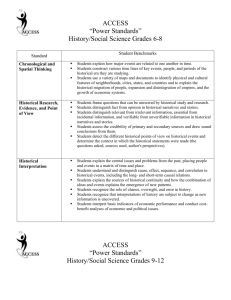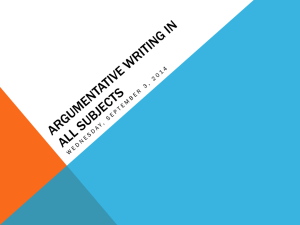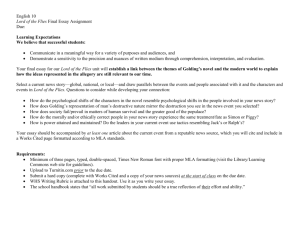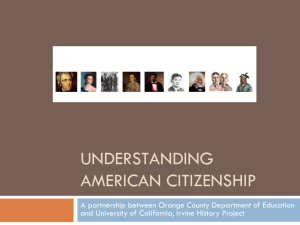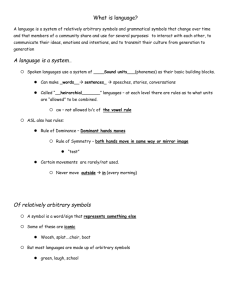5-19-15 Webinar Activity Chart
advertisement
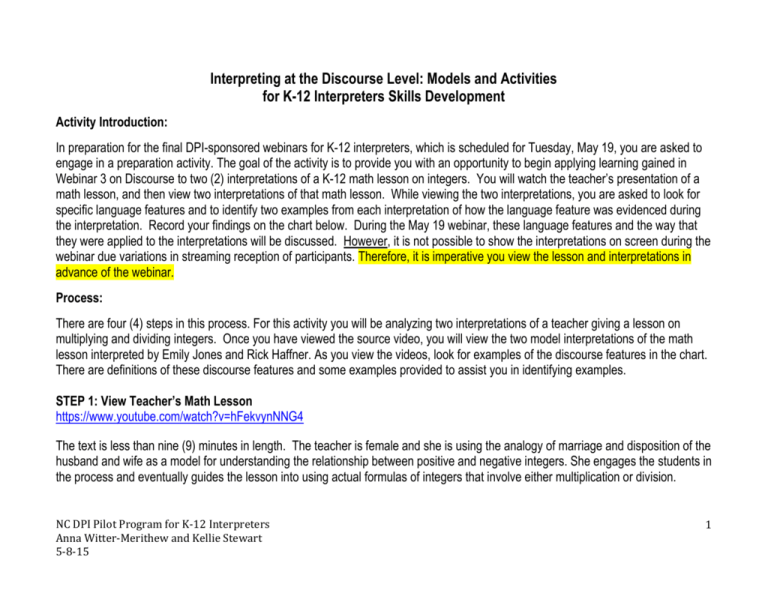
Interpreting at the Discourse Level: Models and Activities for K-12 Interpreters Skills Development Activity Introduction: In preparation for the final DPI-sponsored webinars for K-12 interpreters, which is scheduled for Tuesday, May 19, you are asked to engage in a preparation activity. The goal of the activity is to provide you with an opportunity to begin applying learning gained in Webinar 3 on Discourse to two (2) interpretations of a K-12 math lesson on integers. You will watch the teacher’s presentation of a math lesson, and then view two interpretations of that math lesson. While viewing the two interpretations, you are asked to look for specific language features and to identify two examples from each interpretation of how the language feature was evidenced during the interpretation. Record your findings on the chart below. During the May 19 webinar, these language features and the way that they were applied to the interpretations will be discussed. However, it is not possible to show the interpretations on screen during the webinar due variations in streaming reception of participants. Therefore, it is imperative you view the lesson and interpretations in advance of the webinar. Process: There are four (4) steps in this process. For this activity you will be analyzing two interpretations of a teacher giving a lesson on multiplying and dividing integers. Once you have viewed the source video, you will view the two model interpretations of the math lesson interpreted by Emily Jones and Rick Haffner. As you view the videos, look for examples of the discourse features in the chart. There are definitions of these discourse features and some examples provided to assist you in identifying examples. STEP 1: View Teacher’s Math Lesson https://www.youtube.com/watch?v=hFekvynNNG4 The text is less than nine (9) minutes in length. The teacher is female and she is using the analogy of marriage and disposition of the husband and wife as a model for understanding the relationship between positive and negative integers. She engages the students in the process and eventually guides the lesson into using actual formulas of integers that involve either multiplication or division. NC DPI Pilot Program for K-12 Interpreters Anna Witter-Merithew and Kellie Stewart 5-8-15 1 STEP 2: View Interpreter Models Emily Jones https://www.youtube.com/watch?v=ImzFG3SitK8&feature=youtu.be Rick Haffner https://youtu.be/EbZzgcKtN3I STEP 3: Review Definition of Terms and Questions to Analyze Non-manual markers (NMMs): Definition: The use of raised eyebrows, eye gaze and mouth morphemes to create grammatical meaning in ASL. Question: Examine how NMMs create meaning in the text? Use of fingerspelling: Definition: The incorporation of the ASL alphabet to represent English words or terms. Question: Examine where and how fingerspelling is used to convey academic concepts in a meaningful way? Use of space or visual-spatial structuring: Definition: The use of space by a signer to provide information such as, who is speaking, to refer back to nouns people, places or things, and to create connections between information and ideas. Question: What are two examples of how space is used to ensure meaning is clearly structured? NC DPI Pilot Program for K-12 Interpreters Anna Witter-Merithew and Kellie Stewart 5-8-15 2 Semantics: Definition: Semantics relates to the meaning of individual signs and sign combinations that create meaning in ASL. Question: What are two examples of semantic meaning in these two sample interpretations? Message cohesion: Definition: Cohesion is the glue that sticks a sentence to another in a paragraph or a paragraph to another in a text. It includes how various parts of the message relate to each other, topic shifts or transitions, departures from the topic, and the relationship of various parts of the topic to each other. Question: What are two examples of how message cohesion is created in these two interpretations? Message coherence: Definition: Coherence means that the text is easy to read and understand because the text follows a certain kind of logical order and the organization of ideas is systematical and logical. For example, some kinds of logical order can include chronological order, spatial order, and logical order. Because ASL and English are different languages, message cohesion in ASL may be different than the way it was given in spoken English Question: What are two examples of how message coherence us created in these interpretations? Message Intention: Definition: The instructional strategies the teacher uses when teaching this lesson on integers and whether the interpretations achieved the intended teaching and learning goal. For example, teachers often use scaffolding – or going from concrete to the abstract – to guides student through learning a complex topic. Question: What are two examples of how the instructional strategies of the teacher and overall goal of the lesson were achieved in the interpretations? NC DPI Pilot Program for K-12 Interpreters Anna Witter-Merithew and Kellie Stewart 5-8-15 3 STEP 4: Record Your Findings Feature to Identify Non-manual markers Rick EX: 1 Rick EX: 2 Emily EX: 1 Emily EX: 2 Use of fingerspelling Use of space/spatial structuring Semantics Message cohesion Message coherence Message intention (Achieving the goal) NC DPI Pilot Program for K-12 Interpreters Anna Witter-Merithew and Kellie Stewart 5-8-15 4
